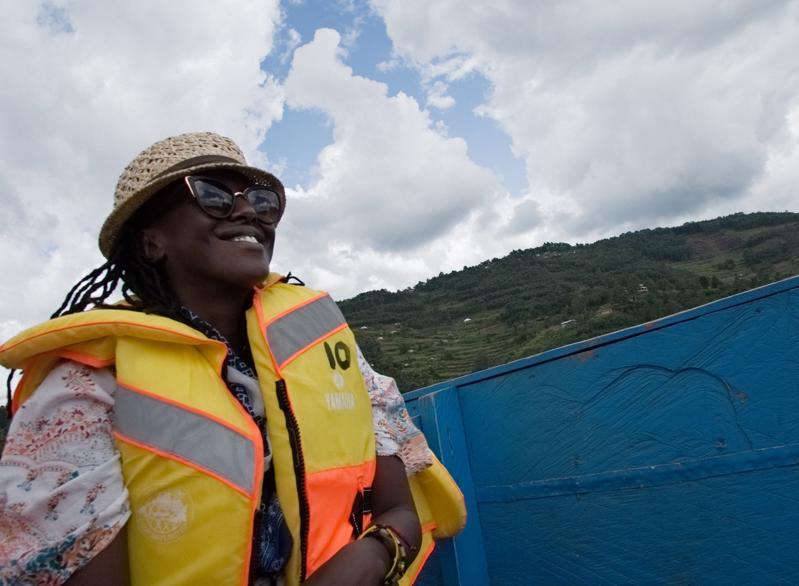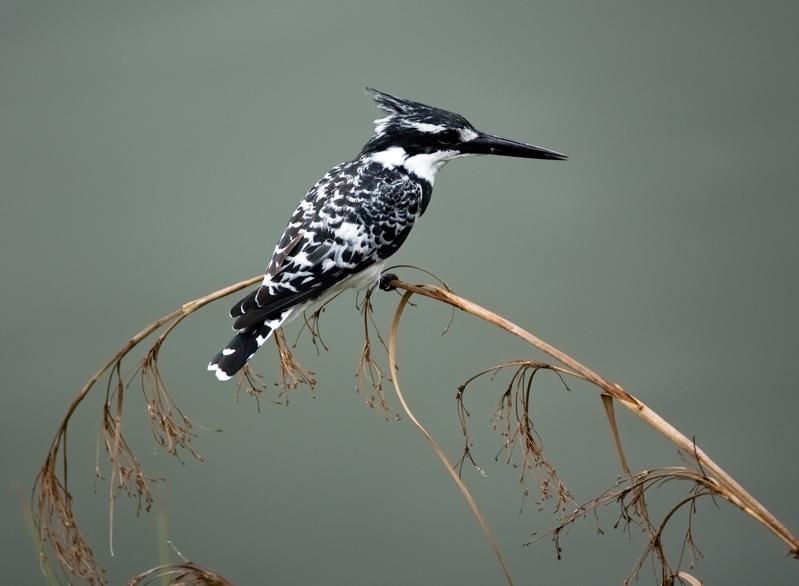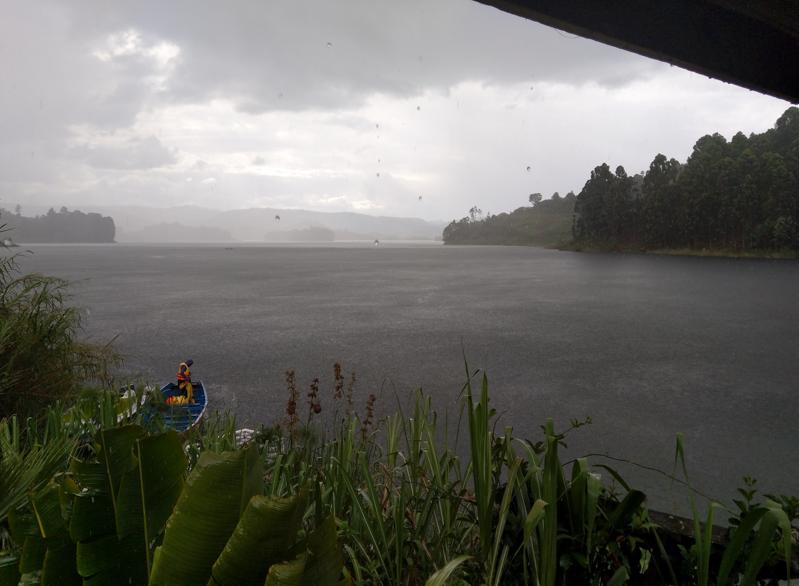Our life Untethered
Yesterday we left lake Bunyoni to head to Bwindi impenetrable forest.
We were leaving such a beautiful place and the second deepest lake in Africa to visit the densest forest in Uganda on the border with Congo.
We had to have another early start, as we wanted to fit in a canoe tour of the lake before our departure. This meant an early breakfast, which is usually a struggle for Caz, but Mark was struggling too. The staff found it strange that we didn’t eat more for breakfast, but our Cat friend Misty (Which we named) was happy with our leftovers.
After an attempt to finish our breakie, we checked out and promised the hotel staff that we would be back next time for a longer visit.
At the dock, our friend Anaise was waiting for us uncharacteristically on time. We had met him on our arrival when we had to commute the last part to the hotel by water, as the roads had been difficult
Carolyn BAGUMA
16 chapters
15 Apr 2020
Chapter 7 - Leaving Lake Bunyoni
Lake Bunyoni Uganda
Yesterday we left lake Bunyoni to head to Bwindi impenetrable forest.
We were leaving such a beautiful place and the second deepest lake in Africa to visit the densest forest in Uganda on the border with Congo.
We had to have another early start, as we wanted to fit in a canoe tour of the lake before our departure. This meant an early breakfast, which is usually a struggle for Caz, but Mark was struggling too. The staff found it strange that we didn’t eat more for breakfast, but our Cat friend Misty (Which we named) was happy with our leftovers.
After an attempt to finish our breakie, we checked out and promised the hotel staff that we would be back next time for a longer visit.
At the dock, our friend Anaise was waiting for us uncharacteristically on time. We had met him on our arrival when we had to commute the last part to the hotel by water, as the roads had been difficult

due to the rain and our guide was worried, we wouldn’t be able to get there.
Anaise (also known as Mr Pineapple) would be taking us on a tour of the different island and sharing the history of the islands. There are X islands, but only X inhabited by locals.
The first island we visited was previously a leper colony, founded by a Scottish visitor that wanted to create somewhere for them to live.
We got to get off our traditional canoe and explore the island which was no longer inhabited by the leper community and the old building we now used for schools and hospitals.
As we walked the island, we passed classrooms full of well-behaved students who stopped to stay at the black and white musungus.
A lot of the locals were baffled by Caz, as they could tell she was Ugandan, but were curious to see her as a tourist.
As we walked the island, we noticed motivational signs posted up on trees dotted around the island. One of Caz’s favourites was the one saying; “Menstruation is not a sin”
After we had finished walking the island, we went to meet our canoe driver who had travelled to the other side of the island to pick us up.
We had learned that a group of Slovenians and the charity Edirisa that

Caz had worked with on her previous visit had been involved in the development of the island.
Our next stop was going to be the ‘Punishment island’, where historically they sent woman/girls who got pregnant out of wedlock.
Before we even got there, Caz was offended by the idea that only the women were punished. She questioned why only the women would be punished this way? To which our guide said it was meant as a deterrent, to which she remarked, ‘’wouldn’t it be a better deterrent to send both people involved in getting pregnant!”.
When we arrived there, we were shocked to find that it was barely an island and more like a small grouping of plants coming out of the lake. It was probably bigger in the past but was still not enough for someone to survive on.
Some women tried to swim to another shore but would have died in the process as most of the community, despite living around water, didn’t know how to swim.
So basically, these women were sent there to die, unless they were lucky enough to be picked up by a poor man with no dowry that take the woman and child as their own.
Thankfully this was no longer practiced and they even stopped exhibiting the skeletons of the dead at the local museum, but it must have really shook Caz up, because as we circled the tiny

island, she was convinced she saw someone standing in the clearing….could have been a ghost or a single short tree eerily positioned.
Our next and more cheerful stop was Eco island, which was part hotel and part zoo.
It was lush and green, and we could see impalas roaming around happily.
We quickly spotted the Golden Monkey hanging in a tree, to which our guide commented on how lucky we were to spot it, as many people came here to see them and didn’t always get a sitting.
As our tour was coming to an end, we learned a little more about Anaise passion project. He had named the project – Mr Pineapple’s (as his name sounded like Ananas) Lake Bunyoni Project
Despite working Mon-Fri on the boats, he volunteered his weekend (and money) to teach the local kids how to swim. It was heart-warming to hear how he supported his sister’s education, but also taught up to 80 local kids over the weekend.
We were shocked to learn that swimming wasn’t part of the local education, even though the lake was almost 900 feet deep and there had been a few deaths on the lake.
We applauded Anaise for giving up his time and money, especially since a set of arm bands cost him about a ¼ of his monthly earning.
We exchanged details with him and promised to stay in touch and help in any way that we can, even being invited to become ambassadors for his project.
We were dropped at the starting dock to meet our driver Hussein and start our 4-hour journey to Bwindi Forest.
It took only an hour to get to the first gate in Bwindi, but we would have an almost 3-hour journey to get to our hotel in the other side of the park.
As soon as we got into the park, we spotted the Golden monkey for the second time that day, and a rare siting of X which is a type of Antelope.
As we travelled through the Park, our guided pointed out some elephant faeces and told us about the forest Elephants that lived in the Valley.
The forest was so dense and steep, we couldn’t imagine how such large animals could climb the valleys.
The rest of the drive was painfully long and slow, as we passed small communities and school kids that stared at the musungu car with fascination.
Despite Bwindi being a premium tourist location, the roads were terrible, and the bumpy ride became tiresome after a couple of hours.
Caz proceeded to take a nap as Mark and Hussein discussed the impact of being near the Congo border and the general politics of Uganda.
We finally arrived at our budget hotel after what felt like the longest time, to be welcomed by the sweet and mild-mannered hotel staff.
There was talk of doing the forest walk we had planned, but we hadn’t eaten anything, and the journey had taken it out of us, so we opted for a late lunch and some time to relax.
We would only be in Bwindi for one night, so we accepted the invitation to go see some of the local orphans perform, who had lost their parents to HIV/AIDS.
We were tired, but we didn’t want to waste the little time we had there, so after a lunch of Spag Bowl and Avocados, we took a quick nap before heading to our evening entertainment.
We had planned to meet one of the hotel staff at the reception to walk us over, but he must have assumed we changed our minds and we could see no sign of him.
We figured we could find our own way and decided to follow the sound of drums and children singing.
We followed another staff member and came out onto what could be described as a high street.
It was lined with Crafts and Souvenir shops, and the first on we landed on we found the member of staff we had been looking for.
He introduced us to Goretti, who worked with the pigmy community to create craft items and support them financially.
Caz was impressed and keen to connect with her as a facilitator to do something similar with the disabled community in Kampala.
We headed to the orphanage to see the performance and were met by sweet and curious faces eager to show their skills. They were aged between 1 and 12 and were a little dishevelled some not even wearing shoes.
They performed a welcome song, which included the locations of the visitors watching and then three traditional dances, including the local Bachiga dance.
As the children sang, bellowed and stamped their feet, and older girl and boy rocked the drums, we commented on the similarities to tap dancing…. but with much tougher feet.
As the performance came to an end, the kids rushed up and grabbed us to dance with them.
As we danced with them, they incorporated our names into the songs they were singing.
The 2-minute dance seemed to be a physical challenge in this altitude.
Once the performances we over, we were invited into the office to learn more about what the organisation does and how we could sponsor a child.
This was such a simple organisation, but it supported a lot of the community that had been damaged by HIV & AIDs, and you could sponsor a child for $300 a year.
After our information session, we were invited to donate and or buy some of the kids’ artwork.
As we exited the office, all the children displayed their gorilla inspired art.
With all their eager faces, it was so hard to pick which pieces to buy, especially since we didn’t have much cash on us, so we just handed them all we had and bought three pieces from 3 children.
As we left, we had to deal with all the other shops trying to sell their wares to us. We suspected that this was a technique that was used to weaken the tourists resolve, but when we learned how the community banded together to help the local kids, we were eager to give more, but didn’t have any more cash on us! So, decided to return to our room and get some more, and promised to come back to all those shops.
Once in the room, we realised that we didn’t have as much cash as planned!
We had booked the hotels through bookings.com, so had assumed that we could pay by card, but as we counted our limited cash, it dawned on us that this might not be the case.
Caz rushed to the hotel reception, only to find that they only accept cash!
We had to arrange for someone to take us to the nearest trading town at an extortionate cost of 20k shillings, for a five-minute drive, but we had no choice to pay as we didn’t have enough money our bill!
As we waited for the driver who was taking his time, we called Hussein to let him know our issue.
Hussein was willing to come back and get us from his accommodation, but we didn’t want to disturb his evening and were already starting to head out.
We had assumed that there would be a proper ATM in the trading town, only to be taken to a crafts shop where they had a machine, but no cash!
Even though we were only there looking for cash, we were uncomfortable that they still seemed to want to sell us stuff.
After realising that the only cash machine in the area was empty, we decided to call Hussein and meet him at his accommodation around the corner.
When we got there, we realised that he planned to take us to the same place to get cash out!
We were getting really panicked at this point, but luckily Hussein offered to give us the cash difference and that we would pay him when we got to an actual town the next.
Caz was so relieved and even hugged him for saving our butts, as we might have had to do dishes for a week!
As we were driven back to the hotel, we mused on the near miss and were shocked to think how many tourists were probably forced to carry thousands of dollars!
We were never comfortable carrying large amounts of money, but here tourists had no choice but to be walking ATMs.
By the time we got back to the hotel, it was dinner time, and we were glad that our meal was included in the price, or we would have gone hungry that night.
With our limited cash, we had to stick to water, as we couldn’t afford any alcohol with dinner and we had already spent it getting a bottle of wine for lunch. Luckily we had our filter bottles to filter tap water.
After Dinner, we asked for the final bill as we knew we couldn’t go to bed until we were sure that we had the right amount of cash.
This ended up being a bigger drama than expected as they only operated in dollars and we knew the price in pounds and were paying in shillings.
As dollars was the preferred currency, there seemed to have no clue on the exchange rate, so they were a few calls to the hotel owner and our tour guide to try and figure out the final sum.
The exchange rate we knew was for Kampala, so there was a little guessing for what it would be in Bwindi.
We finally agreed to the final bill, and when we realised, we would have some cash left over, we sprung for a half bottle of Bond 7 whisky & coke to end the evening on a relaxed note.
The relaxation didn’t last long, when our drinks were delivered to our room, the member of staff was still unsure about the final price and offered us to make our own calculations and tell them the amount the following morning! It was strange to have to tell a hotel how much we were going to pay.
We weren’t interested in doing new calculations, so we just decided we would stick to the amount discussed and had an early night, as we had a forest walk planned early before we left Bwindi.
1.
Chapter 1 - The long journey
2.
Chapter 2 - Power of a smile
3.
Chapter 3 - The Boda Way
4.
Chapter 4- The Rain
5.
Chapter 5 - On the road to Mburo
6.
Chapter 6 - Lake Mburo Safari Walk
7.
Chapter 7 - Leaving Lake Bunyoni
8.
Chapter 8 - Wildlife of Uganda
9.
Chapter 9 - Bwindi Forest Walk
10.
Chapter 10 - Journey to Fort Portal
11.
Chapter 11 - Trying to reduce plastic
12.
Chapter 12 - Road to Nairobi
13.
Chapter 13 - A few nights in Nairobi
14.
Chapter 14 - Working at Yaapha
15.
Chapter 15 - Trumper
16.
Chapter 16 - Oasis in Arusha
Share your travel adventures like this!
Create your own travel blog in one step
Share with friends and family to follow your journey
Easy set up, no technical knowledge needed and unlimited storage!
© 2025 Travel Diaries. All rights reserved.